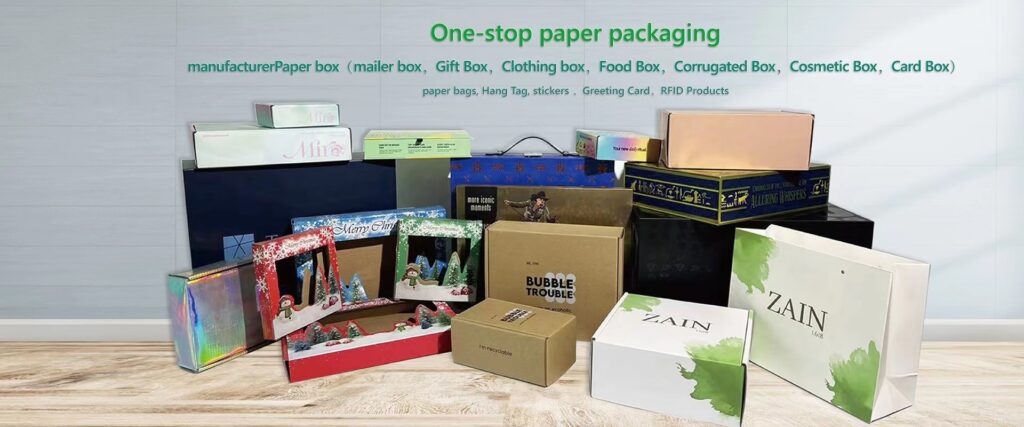
W dzisiejszym, ciągle zmieniającym się świecie, niestandardowe pudełka opakowaniowe Branża jest na czele zmian, wdrażając najnowocześniejsze technologie i kładąc większy nacisk na zrównoważony rozwój, aby na nowo zdefiniować doświadczenia klienta. Te innowacje zmieniają nie tylko sposób pakowania produktów, ale także sposób, w jaki klienci postrzegają marki i wchodzą z nimi w interakcje. Dzięki tym przełomowym rozwiązaniom klienci mogą cieszyć się holistycznym doświadczeniem zakupowym, otrzymując swoje zakupy w ekologicznych, artystycznie wykonanych i najwyższej jakości, spersonalizowanych opakowaniach. Te postępy nie tylko zapewniają bezpieczny transport towarów, ale także budują głębszą więź z konsumentami na poziomie mentalnym, sensorycznym i emocjonalnym.
W tym artykule przyjrzymy się bliżej dziesięciu innowacjom, które obecnie na nowo definiują niestandardowe pudełka do pakowania.
Spis treści
1. Zrównoważony rozwój: Zmiana w kierunku zrównoważonego rozwoju
Rewolucja w zakresie zrównoważonych opakowań to kluczowa innowacja, która rewolucjonizuje branżę opakowaniową. Ostatnie badania pokazują, że 77% konsumentów preferuje opakowania swoich produktów wykonane z materiałów ekologicznych. To skłoniło wiele firm do przejścia na opakowania ekologiczne, doceniając ich atrakcyjność dla konsumentów dbających o środowisko. Co więcej, badanie przeprowadzone przez Survey Monkey wykazało, że co trzeci klient aktywnie poszukuje opakowań przyjaznych dla środowiska, a 35% respondentów deklaruje gotowość do zapłacenia nieco więcej za produkty zapakowane w materiały ekologiczne. Wraz z rosnącą popularnością zrównoważonego rozwoju, trendy takie jak redukcja śladu węglowego, minimalizacja odpadów i promowanie recyklingu zyskują na popularności.
2. Opakowania jadalne: zrównoważony rozwój zmienia się na lepsze
Jadalne alternatywy stały się przełomową innowacją w sektorze opakowań. Służą one dwóm celom: zmniejszają naszą zależność od paliw kopalnych, a jednocześnie stanowią ekologiczne rozwiązanie opakowaniowe. Do produkcji tych jadalnych, niestandardowych opakowań wykorzystuje się naturalne materiały, takie jak włókna roślinne, rośliny uprawne, wodorosty i algi. Co więcej, nie ograniczają się one do spożycia przez ludzi; nadają się również dla zwierząt.
3. Opakowania oszczędzające miejsce i elastyczne: wydajność transportu i magazynowania
Innowacje w dziedzinie opakowań nie ograniczają się wyłącznie do kwestii zrównoważonego rozwoju i możliwości recyklingu. Obejmują one również kwestie transportu i magazynowania. Nadmierny transport, masowa produkcja i magazynowanie niestandardowych materiałów opakowaniowych mogą mieć negatywny wpływ na środowisko. Jednak najnowsze innowacje w zakresie rozwiązań oszczędzających miejsce umożliwiły stawienie czoła tym wyzwaniom. Rozwój elastycznych opakowań, charakteryzujących się lekkimi i trwałymi materiałami o precyzyjnych wymiarach i rodzajach, zmienia oblicze branży opakowaniowej.
4. Inteligentne opakowania technologiczne: nowa era interaktywności
Poza opakowaniami spożywczymi i elastycznymi, branża opakowaniowa jest zaskoczona postępem w dziedzinie inteligentnych technologii. Inteligentne opakowania, znane również jako aktywne lub inteligentne, dynamicznie się rozwijają w ostatnich latach. Według badań Grand View Research, przychody generowane z inteligentnych opakowań osiągnęły 14 biliony dolarów w 2015 roku i według prognoz mają wzrosnąć do 14 bilionów dolarów w 2024 roku. Inteligentne opakowania otwierają nową erę dla marek, umożliwiając wygodne śledzenie i rejestrowanie zachowań klientów, oferując tym samym bardziej angażujące i immersyjne doświadczenie. Te postępy technologiczne zwiększają zaangażowanie klientów w produkt i napędzają produktywność.
5. Trendy materiałowe: Różnorodna paleta materiałów
Innowacje materiałowe są kluczową siłą napędową transformacji w branży opakowaniowej. Materiały takie jak włókna roślinne, bambus, komponenty odporne na zarysowania i jadalne alternatywy zapoczątkowały rewolucję materiałową. Co więcej, tektura falista nie straciła na atrakcyjności, pozostając popularnym wyborem w branży opakowaniowej. Dane rynkowe na świecie wskazują, że wartość tektury falistej, szacowana na 14 biliony ton (155 miliardów ton), ma się podwoić do 2025 roku.
6. Postęp w druku 3D w produkcji: Tworzenie złożonych produktów
Branża opakowaniowa przechodzi transformację nie tylko pod względem materiałów i wzornictwa, ale także w obszarze produkcji. Procesy produkcyjne przeżywają falę innowacji wraz z pojawieniem się zaawansowanych technologii i odkryć. W szczególności druk 3D stał się centralnym punktem, umożliwiając tworzenie starannie zaprojektowanych, niestandardowych opakowań. Technologia ta pozwala na drukowanie opakowań o zwiększonej elastyczności, wydajności i opłacalności.
7. Sztuczna inteligencja i automatyzacja maszyn w Niestandardowe pudełka do pakowania:Podnoszenie wydajności
Rola technologii wykracza poza ramy niestandardowych opakowań, sięgając w obszar sprawnej dostawy produktów. Klienci coraz częściej oczekują opakowań najwyższej jakości i szybkiego czasu realizacji. Aby sprostać tym oczekiwaniom, integracja automatyzacji procesów robotycznych z obliczeniami kognitywnymi okazuje się nieoceniona. Wraz z rozpoczęciem wykonywania zadań przez roboty, zwiększają one produktywność i usprawniają realizację zamówień hurtowych.
8. Automatyzacja dostaw do konsumentów: era zautomatyzowanej logistyki
Postęp technologiczny sprawił, że bezproblemowa dostawa produktów do klientów stała się rzeczywistością. Pojawienie się metod dostaw, takich jak dostawy za pomocą dronów Amazona i autonomicznych pojazdów Ubera, dowodzi wykonalności zautomatyzowanej logistyki. Marki oferują obecnie klientom zautomatyzowane dostawy, skutecznie dotrzymując terminów dostaw. W branży opakowań wielu producentów również wdrożyło zautomatyzowane metody dostaw, aby zwiększyć efektywność swojego łańcucha dostaw.
Podsumowanie: Przyszłość kształtowana przez innowacje
W istocie, te innowacje technologiczne zapoczątkowały nową erę w branży opakowań niestandardowych. Od większego nacisku na zrównoważony rozwój po integrację najnowocześniejszych technologii, każdy aspekt branży przeszedł transformację, przynosząc korzyści zarówno klientom, jak i firmom. Te postępy nie tylko usprawniają dostarczanie produktów w zrównoważonych opakowaniach, ale także sprzyjają ochronie środowiska i zwiększają produktywność. Można śmiało powiedzieć, że technologia jest siłą napędową przyszłości. Wykorzystując te innowacje i dostosowując się do stale zmieniających się potrzeb branży opakowaniowej i jej konsumentów, firmy mogą utrzymać przewagę i nadal prosperować w dynamicznie zmieniającym się otoczeniu.
